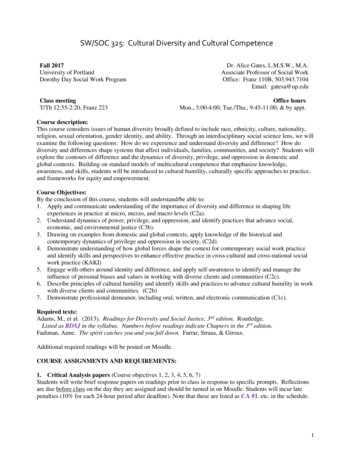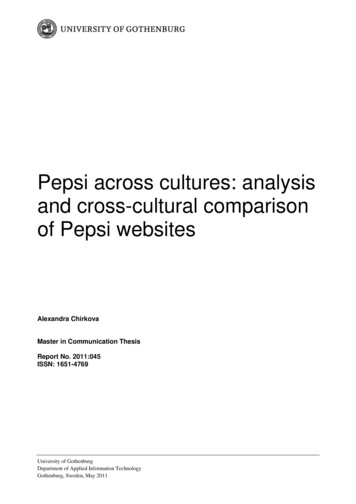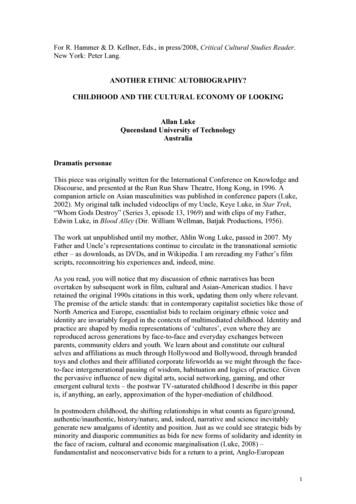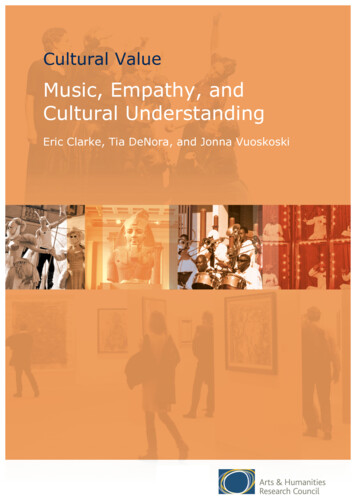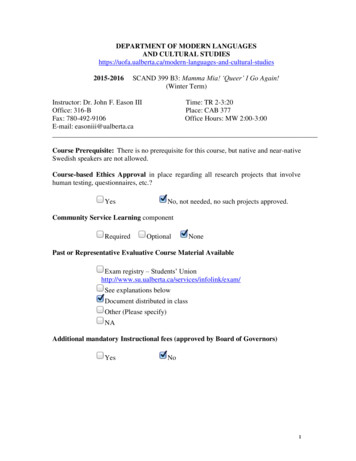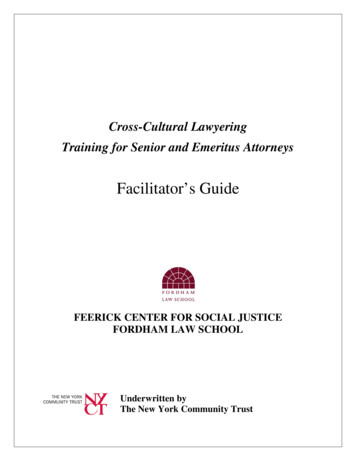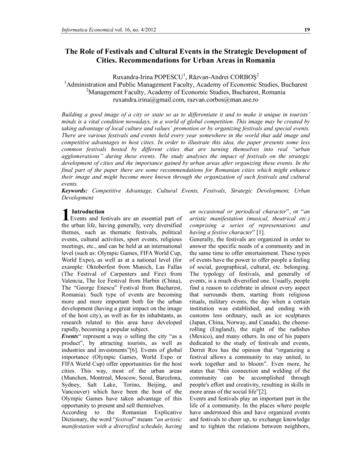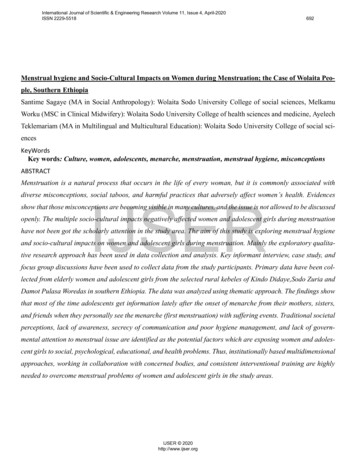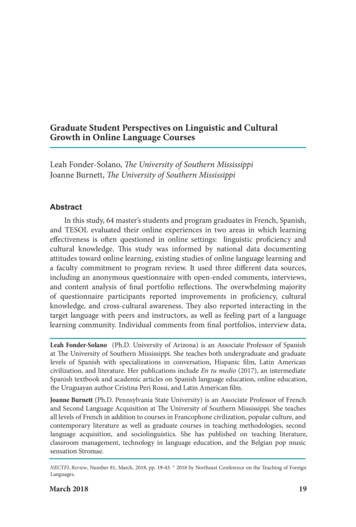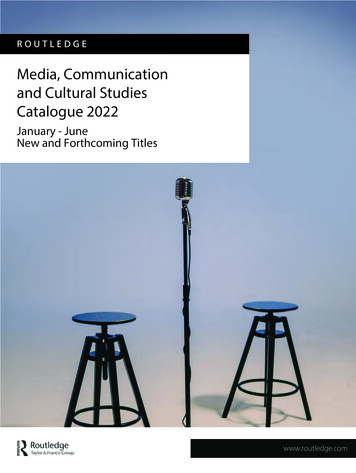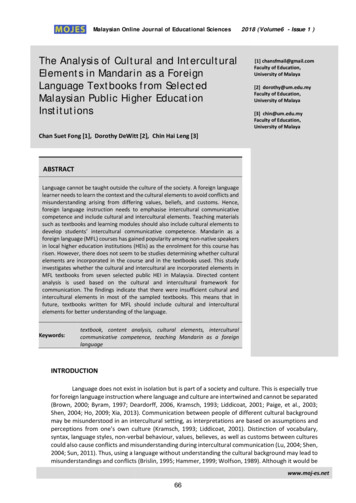
Transcription
Malaysian Online Journal of Educational SciencesThe Analysis of Cultural and InterculturalElements in Mandarin as a ForeignLanguage Textbooks from SelectedMalaysian Public Higher EducationInstitutions2018 (Volume6 - Issue 1 )[1] chansfmail@gmail.comFaculty of Education,University of Malaya[2] dorothy@um.edu.myFaculty of Education,University of Malaya[3] chin@um.edu.myFaculty of Education,University of MalayaChan Suet Fong [1], Dorothy DeWitt [2], Chin Hai Leng [3]ABSTRACTLanguage cannot be taught outside the culture of the society. A foreign languagelearner needs to learn the context and the cultural elements to avoid conflicts andmisunderstanding arising from differing values, beliefs, and customs. Hence,foreign language instruction needs to emphasise intercultural communicativecompetence and include cultural and intercultural elements. Teaching materialssuch as textbooks and learning modules should also include cultural elements todevelop students’ intercultural communicative competence. Mandarin as aforeign language (MFL) courses has gained popularity among non-native speakersin local higher education institutions (HEIs) as the enrolment for this course hasrisen. However, there does not seem to be studies determining whether culturalelements are incorporated in the course and in the textbooks used. This studyinvestigates whether the cultural and intercultural are incorporated elements inMFL textbooks from seven selected public HEI in Malaysia. Directed contentanalysis is used based on the cultural and intercultural framework forcommunication. The findings indicate that there were insufficient cultural andintercultural elements in most of the sampled textbooks. This means that infuture, textbooks written for MFL should include cultural and interculturalelements for better understanding of the language.Keywords:textbook, content analysis, cultural elements, interculturalcommunicative competence, teaching Mandarin as a foreignlanguageINTRODUCTIONLanguage does not exist in isolation but is part of a society and culture. This is especially truefor foreign language instruction where language and culture are intertwined and cannot be separated(Brown, 2000; Byram, 1997; Deardorff, 2006, Kramsch, 1993; Liddicoat, 2001; Paige, et al., 2003;Shen, 2004; Ho, 2009; Xia, 2013). Communication between people of different cultural backgroundmay be misunderstood in an intercultural setting, as interpretations are based on assumptions andperceptions from one’s own culture (Kramsch, 1993; Liddicoat, 2001). Distinction of vocabulary,syntax, language styles, non-verbal behaviour, values, believes, as well as customs between culturescould also cause conflicts and misunderstanding during intercultural communication (Lu, 2004; Shen,2004; Sun, 2011). Thus, using a language without understanding the cultural background may lead tomisunderstandings and conflicts (Brislin, 1995; Hammer, 1999; Wolfson, 1989). Although it would bewww.moj-es.net66
Malaysian Online Journal of Educational Sciences2018 (Volume6 - Issue 1 )unrealistic to expect learners of a foreign language to achieve the communicative competence of anative speaker and assimilate into the target culture, the learner still needs to acquire the use of thetarget language in specific social and cultural contexts (Liddicoat, 2001; Risager, 1998). Learners needto learn the context and culture for communication (Gudykunst & Kim, 1992; Paige, 2003). Hence,cultural elements need to be included in the foreign language curriculum (Byram, 1997; Deardorff,2006; Jin, 2012).The intercultural approach in foreign language teaching promotes linguistic competence aswell intercultural communicative competence (ICC), and aims at developing awareness of the culturaldifferences which may interfere with communication and understanding between the learner’s ownculture and the target culture (Byram, 1997; Byram et al., 2002; Kramsch, 1993). The goals for thecultural learning include learning culture and its impact on human communication, behaviour andidentity. There is cultural-specific learning, which involves the acquisition of knowledge and skillsrelevant to a target culture, and culture-general learning, which refers to the knowledge and skillsthat are generalizable and transferable across the culture such as cultural adjustment and learningin the cross-linguistics interactions (Paige, 1997; Paige et al., 2003). In recent years, cultural learningin a foreign language is focused on higher order learning outcomes rather than a static cultureinvolving memorization of cultural facts (Liddicoat, 2001; Paige et al., 2003). Therefore, mastering aforeign language alone does not ensure one’s competency in the intercultural communication, andICC is not a naturally occurring phenomenon, numbers of researchers have pointed out that culturelearning needs to be explicitly addressed in foreign language curriculum (Byram, 1997; Deardorff,2006; Jin, 2013; Kramsch, 1993; Robinson, 1978; Stern, 1983).Thus, in light of the necessity to equip MFL learners in local HEIs with communicativecompetence to cope with the variety and complex social contexts, it is essential that teachingmaterials comprising of textbooks and modules are designed to include cultural and interculturalelements as well as relevant pedagogical strategies. Textbooks are an important resource forinstruction in a course of study (Cunningsworth, 1995). As the core resource material in a course,textbooks serve as the basis for language input in the classroom (Tomlinson, 1998; Wu, 2010). Inaddition, when teachers use textbooks for planning their instruction, it can impact the teacher’sdelivery of content (Cunningsworth, 2002).There was a rapid expansion in MFL courses in local higher education institutions over thepast two decades (Fan, 2011; Hoe, 2014; Yap, 2011). At present, all 20 public HEIs in Malaysia offerMFL as an elective course, and three of the universities offered MFL as a minor programme (Hoe,2014; Yap, 2011). MFL is also offered in Malaysian polytechnics, vocational colleges, as well as privateuniversities and colleges in Malaysia (Hoe, 2012). The enrolment for MFL has been increasing inrecent years as more Malaysian non-native speakers are taking this course. There was a total of21,693 students enrolled for MFL courses in one semester in 20 public universities in Malaysia basedon the statistics in 2011 (Hoe, 2014).Most of the local public HEIs was employed textbooks which published from China (36.8%)and some compiled based on adaptation of China published MFL textbooks and local published MFLtextbooks (26.4%) (Hoe, 2014). However, there was limitation of China MFL textbooks in terms ofcultural and intercultural dimension, such as non-systematic and non-standard of cultural contents(Wang, 2014); and intercultural communication consciousness were insufficient and not givenattention in the contents (Deng, 2012; Zhou, 2004). The MFL textbooks published from China wasdesigned and developed based on the China social context, and not considered the characteristics oflocal peoples, culture and social environment, the textbooks were more adequate for the teachingof Mandarin as a second language, and not for teaching Mandarin as a foreign language as in Malaysia(Wang, 2016).In terms of local published MFL textbooks, Tan’s (2007) research discovered that majority ofthe local MFL textbooks was emphasized on linguistics skills, and the inclusion of cultural knowledgein the textbooks was insufficient. However, Tan did not elaborate in what extend the culturalknowledge was absent in the sample textbooks and suggestions for the cultural content for MFLtextbooks was not provided. The research gaps need to be answered by further studies. Hoe’s (2016)www.moj-es.net67
Malaysian Online Journal of Educational Sciences2018 (Volume6 - Issue 1 )survey on 20 local public higher education institutions (HEIs) and reported that majority of the publicHEIs did not include much cultural information in the textbooks, only some information concerningChinese festival and local festivals were found from some textbooks. Cultural knowledge wasintegrated through students’ assignment as formative assessments and co-curricular activities in afew public HEIs. However, detail information on cultural and intercultural content from the MFLtextbooks for each HEIs was not provided by Hoe (2016).Due to the limited studies concerning the cultural and intercultural elements incorporated inthe local published MFL textbooks, the present study seeks to to fill the research gaps by investigatingthe cultural and intercultural elements presented in selected MFL textbooks or modules of local HEIsby employing a content analysis.LITERATURE REVIEWCultural Elements in Foreign Language TextbooksThere are various cultural models which have been adopted for foreign language instruction.There are two major types of models: the static view of culture, and the dynamic view of culture(Liddicoat, 2001). The static view of culture treats culture as facts and artifacts such as informationon the country, people, their lives, history, institution, customs, cultural icons such as literature, art,architecture or music while the dynamic view of culture considers culture as a set of practices inwhich people engage and involve with linguistic and non-linguistic practices of culture (Liddicoat,2001). The language-speaker demonstrates intercultural competence when he knows how languageis in the culture and understands the way of living in a particular cultural context (Liddcoat, 2001).Risager (1991) has employed a framework to study cultural content in the foreign languagetextbooks comprising of micro and macro levels of the culture, as well as the intercultural issues. Themicro level of culture refers to the social and cultural anthropology phenomena which covers thesocial characters, situation of interaction, the subjectivity of the characters in feeling, attitudes,values and perceiving. The macro level of culture relates to the social, political, and historical matters.The foreign language textbooks need to touch upon the intercultural issues and make comparisonsbetween the target culture and the learners own culture to avoid the stereotypes and conflictsamong cultures (Risager, 1991; Byram, 1997). This is because learners tend to interpret the situationaccording to their own culture and expectation, often leading to misunderstanding (Kramsch, 1993).Byram and Planet (2000) pointed out that making comparisons made the strange culture becomefamiliar, and thus easier to accept. Learners will also acquire deeper understanding of their ownculture and appreciate the differences between the two cultures (Liddicoat, 2001).The teaching foreign language curriculum used in Europe and North America emphasized theBig C and Little c culture. The elements of Big C culture refer to achievement culture such as art,literature, music, architecture, heritage of civilization and thought (Lussier, 2011). Little c culturerefers to behaviour culture, and culturally-influenced beliefs and perceptions, or ideas (Tomalin &Stempleski, 1993, Lussier, 2011). Behaviour refers to customs, habit, dress, foods, and leisure, as wellas ideas related to beliefs, values and institutions (Tomalin & Stempleski, 1993).The Little c culture (Tomalin and Stempleski, 1993; Lussier, 2011) and Micro-Level Culture(Risager, 1991) reflect similar characteristics, as they refer to behaviors and ideas such as customs,habit, foods, dress, leisure, beliefs, values, behavior, moral, institution and norm, social identity,social interaction, daily routines.Cultural Elements in Mandarin as a Foreign Language TextbooksCultural content for teaching MFL was divided into two categories from the functionalapproach: communicative-culture and knowledge-culture (Zhang, 1990). Communicative-culturewas referred to linguistic and non-linguistic cultural elements that influence the accuracy of themessages exchanged, which may result in miscommunication or misunderstanding when two peoplefrom different cultural backgrounds communicate, while knowledge-culture refers to the linguisticand non-linguistic cultural elements which do not directly influence the accuracy of the exchange ofmessages (Zhang, 1990).www.moj-es.net68
Malaysian Online Journal of Educational Sciences2018 (Volume6 - Issue 1 )Chen (1992) categorised the cultural elements of communicative-culture in languagestructure (语构), meaning (语义) and pragmatics (语用). The cultural elements in language structurewas reflected in the grammatical structure, through the construction or formation of the vocabulary,phrases, sentences, rhetoric and idioms. It embodies the cultural features and characteristics,thoughts, principle and ideology of the people (Chen 1992, Liu, 2002; Xia, 2013), such as collectivism,emphasized on hierarchical and patriarchal. For example, the structure for the phrase “Lǐ xiǎojiě李小姐” (Miss Li), places the surname “Li李” before the noun “xiǎojiě小姐” (miss) was contrary fromthe English and Malay language structure in which the surname is placed after the given name, asChinese placed importance and respected hereditary ancestral surnames, placing priority to thefamily rather than the individual (Ding, 2010; Shen, 2004).The cultural elements in “meaning” were displayed in vocabulary, lexis, idiom, proverb,saying, metaphor, and symbolization that demonstrated the unique concept, meaning and thoughtsof the Chinese and the concepts may sometimes have no equivalent meaning in other languages orwith diverse meaning (Chen, 1992; Liu, 2002; Xia, 2013). Learners may not understand the meaningof the vocabulary if they did not study the cultural meaning, and cause misunderstanding whencommunicate with the native speakers. There were many vocabularies in Mandarin which embodiedthe cultural elements in meaning, such as lóng龙 (dragon),gǒu 狗 (dog), zhú竹 (bamboo), etc. (Liu,2002). For example, lóng龙 (dragon) brought specific meaning in Chi
textbook, content analysis, cultural elements, intercultural communicative competence, teaching Mandarin as a foreign language INTRODUCTION. Language does not exist in isolation but is part of a society and culture. This is especially true for foreign language instruction where language and culture are intertwined and cannot be separated (Brown, 2000; Byram, 1997; Deardorff, 2006, Kramsch .
